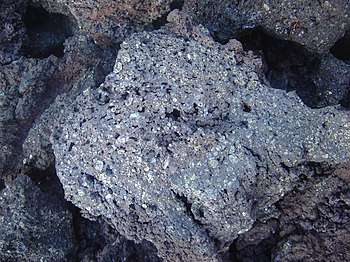Picrite basalt
Picrite basalt, picrobasalt is a variety of high-magnesium olivine basalt that is very rich in the mineral olivine. It is dark with yellow-green olivine phenocrysts (20 to 50%) and black to dark brown pyroxene, mostly augite.

The olivine-rich picrite basalts that occur with the more common tholeiitic basalts of Kīlauea and other volcanoes of the Hawaiian Islands are the result of accumulation of olivine crystals either in a portion of the magma chamber or in a caldera lava lake. The compositions of these rocks are well represented by mixes of olivine and more typical tholeiitic basalt.
The name "picrite" can also be applied to an olivine-rich alkali basalt: such picrite consists largely of phenocrysts of olivine and titanium-rich augite pyroxene with minor plagioclase set in a groundmass of augite and more sodic plagioclase and perhaps analcite and biotite.
Picrites and komatiites are somewhat similar chemically, but differ in that komatiite lavas are products of more magnesium-rich melts, and good examples exhibit the spinifex texture. In contrast, picrites are magnesium-rich because crystals of olivine have accumulated in more normal melts by magmatic processes. Komatiites are largely restricted to the Archean.
When the term oceanite was apparently first proposed by Antoine Lacroix, he used the term to apply only to basalts with more than 50% olivine content (an extremely rare occurrence). Picrite basalt is found in the lavas of Mauna Kea and Mauna Loa in Hawaiʻi, Curaçao, in the Piton de la Fournaise volcano on Réunion Island and various other oceanic island volcanoes.
- Picrite basalt has been erupted in historical times from Mauna Loa during the eruptions of 1852 and 1868 (from different flanks of Mauna Loa).
- Picrite basalt with 30% olivine commonly erupts from the Piton de la Fournaise.
Oceanite
Oceanite is the name of variety of picritic basalt characterized by its large amounts of olivine phenocrysts and lesser amounts of augite and by having a groundmass of olivine, plagioclase and augite. The term was coined by Antoine Lacroix in 1923.[1]
Common uses
Olivine basalt is commonly used by foundries, boilermakers and boiler users to protect the area around a burner tip or to protect a floor from molten metal and other slag. Its use in this fashion is appropriate since olivine is a highly refractory, high-melting-temperature mineral.
References
- Le Maitre (ed.) 2002, p. 118.
- ^ Carmichael, Ian S. E., Turner, Francis J., and Verhoogen, John (1974). Igneous Petrology, McGraw-Hill, pp. 406 – 426.
- ^ Metrich, Nicole, Françoise Pineau and Marc Javoy (1988). Volatiles : Mantle Source Characterization and Degassing Process for Hot Spot Volcanism - The Piton de la Fournaise (Reunion Island) Example at the Wayback Machine (archived 8 November 2005)
- ^ Kerr, A. C. (1997). What is the difference between a komatiite and a picrite? at the Wayback Machine (archived 22 June 2004).
- ^ Le Maitre, L. E., ed. (2002). Igneous Rocks: A Classification and Glossary of Terms 2nd edition, Cambridge.
- ^ Rhodes, J. M. (1995). The 1852 and 1868 Mauna Loa Picrite Eruptions Geophysical Monograph Series, vol. 92, AGU, Abstract retrieved 18 February 2006.
- Wilkinson, J. F. G.; Hensel, H. D. (1988). "The petrology of some picrites from Mauna Loa and Kilauea volcanoes, Hawaii". Contributions to Mineralogy and Petrology. 98 (3): 326–345. doi:10.1007/bf00375183.CS1 maint: ref=harv (link)
- ^ Williams, Howel, Francis J. Turner, and Charles M. Gilbert (1954). Petrography W. H. Freeman, pp. 40 – 41.